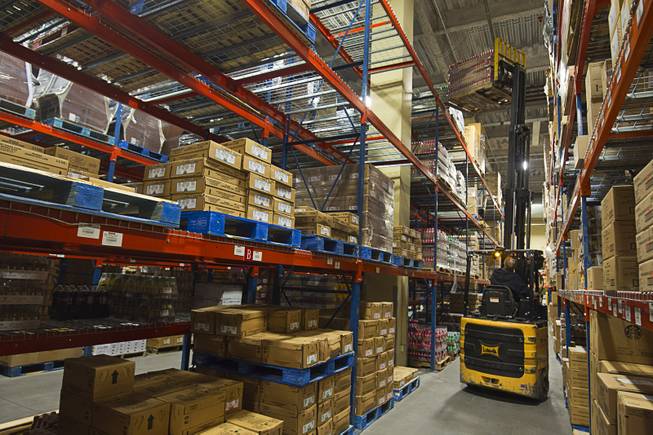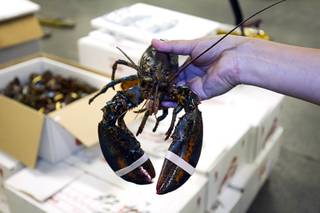
A warehouse attendant uses a Bendi articulating forklift to pull a pallet off a shelf in the Aria dry storage room at Aria Tuesday, June 30, 2015. The articulating lift allows for narrower aisles and more shelf space.
Sunday, Sept. 6, 2015 | 2 a.m.
By the numbers
• 57,398: Size of Aria's on-site warehouse, in square feet. Aria employs 33 attendants, five supervisors and one manager at its on-site warehouse.
• 110,000: Size of Aria's off-site warehouse, in square feet. One manager, one attendant and one inventory control clerk work at Aria’s off-site warehouse.
Aria’s on-site warehouse stores primarily food and beverages. All other supplies, such as extra furniture, bedding and towels, are stored in Aria’s off-site warehouse and transported to the main warehouse as needed.
The inventory control staff includes 13 material runners, seven inventory control clerks, four senior control clerks, one manager, one supervisor, and one cost accountant.
Tight fit
Aisles in most warehouses sit 10 feet apart, but some in Aria’s dry storage room sit only 7 feet apart to squeeze in more racks. Aria has special forklifts that can operate in narrow aisles.
Peak days
The dock’s busiest days are Tuesdays and Fridays — Tuesdays to replenish whatever ran out over the weekend and Fridays to stock up for the coming weekend, Operations Controller Doug Walker said.
Food and drink flow abundantly on the Strip. You can order lobster, steak, wine and countless other items in seemingly endless quantities.
The illusion of infinite availability exists thanks to a well-oiled delivery, intake and storage system operating quietly behind the scenes.
Staff at Aria opened the doors to the its loading docks and freezers to unveil how food, drinks and goods make their way through the Strip resort.
How it works
1. A truck rolls into the underground delivery area, and the driver pulls up to one of Aria’s six receiving bays. He or she hands a purchase order number to a warehouse attendant, who looks in a computer to find the corresponding receiving worksheet, which specifies the products and quantities to be delivered.
2. The attendant also inspects the product for defects and rejects any bad items.
3. After the inspection process, the attendant delivers the receiving document to the input office so the product can be recorded into Aria’s inventory system. The product itself is transported to one of many rooms in Aria’s warehouse for holding.
A busy space
Most receiving docks on the Strip are outdoors. However, due to limited street space, the loading docks for all CityCenter properties were built
21 feet underground — a welcome relief for workers who make and process deliveries during the scorching summer months.
Trucks begin pouring into Aria’s receiving bays when they open at 5 a.m. By the time the dock closes at 3 p.m., 100 or more trucks will have rolled through. The dock usually is busy all day, except for a slight slowdown between 9 and 11 a.m. because of truck scheduling, Aria Warehouse Manager Dave Belmonte said.
Where food and beverages are stored in Aria’s on-site warehouse
• Dairy box, 38 degrees Fahrenheit: The dairy box holds all hard dairy products, such as cheese and hardboiled eggs. Items are stored on racks that are slanted, so fresher products can be loaded onto the back of the rack and gravity will help older items slide to the front. The warehouse is responsible for ensuring product freshness and absorbing any losses from food that has gone bad.
• Produce box, 38 degrees: The produce box holds all of Aria’s produce, except for a few products that must be stored at warmer temperatures. Produce also is stored on slanted racks.
• Milk room, 36 degrees: Aria’s milk is stored separately from the rest of the dairy products. A vendor visits six days a week to service the milk room. The vendor is responsible for ensuring the milk is fresh and for replacing any spoiled milk.
• Dry storage, room temperature: At 27,292 square feet, the dry storage room is the largest in Aria’s warehouse.
• Meat cooler, 36 degrees: Meat for the resort is stored in the warehouse’s meat cooler. Some, including steak, is cut fresh each day by an in-house butcher. The butcher also prepares hamburgers, sausages and fajita meat.
• Liquor room, room temperature: Much of Aria’s hard alcohol is stored in the liquor room, which is home to 50 kinds of scotch. Vodka makes up the largest portion of the liquor room’s stock since it is the resort’s No. 1 seller. The most expensive bottle in the room is the $56,000 Louis XIII Black Pearl cognac.
• Red wine room, 52 degrees (with a higher humidity to keep corks from drying out): The red wine room is twice as large as the white wine room, and its conditions mimic those in a typical wine cellar — cool but not cold, and slightly humid. The room houses 178 types of wine. Bananas, tomatoes and herbs also are stored in the red wine room, since they have to be kept at slightly higher temperatures. The room also is home to a dragon, a witch and the Grinch — all made from chocolate. The red wine room is best suited to store the seasonal chocolate sculptures displayed at Jean Philippe Patisserie at Aria and Bellagio. The sculptures are stored in the red wine room and used year after year until the chocolate is melted down to make a new sculpture.
• White wine room, 38 degrees (with a higher humidity): The white wine room is home to 133 kinds of wine, which are stored in bulk and held by the case. Operations Controller Doug Walker said that when he worked at the Mirage, the white wine room was bigger than the red wine room. But over time, people’s tastes changed and red wine became more popular, so managers had to flip the rooms. Aria opened in 2009, and its red wine room was built to be larger than its white white room.
• Beer box, 38 degrees: The beer box holds beers of all types, from Blue Moon ($22.57 per case) to Cascade Apricot ($238 per case). Aria prepares for the three biggest drinking holidays of the year — Memorial Day, Fourth of July and Labor Day — by ordering extra stock. For instance, in preparation for the Fourth, Aria ordered five pallets of Corona (45 cases per pallet), four pallets of Bud Light (56 cases per pallet) and one pallet of Budweiser (56 cases per pallet). Aria also varies the kind of beer it orders based on the holiday; for example, ordering more Corona for Cinco de Mayo.
• Lobster room, 34 degrees: The lobster room is home to four tanks, each of which holds a particular weight of lobster — 1 pound, 1 1/2 pounds, 2 to 2 1/2 pounds and 3 1/2 to 4 pounds. Lobsters are delivered alive, so attendants inspect them for freshness by tickling their undersides to see if they respond and by holding them up to see whether their tails droop. Lobsters can last about 48 hours out of water, but they must be “purged” before entering the storage tank, since they relieve themselves upon re-entering water. The purge process is done in a special tank before the lobsters are transferred for storage. The lobsters are not fed while stored in the tanks, and a protein skimmer pulls urine out of the water.
• Freezer, 10 degrees below zero: The freezer is the coldest and most crowded room in the warehouse, though it is one of the Strip’s larger freezer rooms, Walker said. The freezer is home to an array of goods, from frozen chicken to ice cream. Workers have to use pencils when inventorying the room, since ink would freeze.
• Thaw cooler, 38 degrees: Shrimp and crab legs are shipped frozen to Aria, which means that once a day, they must be thawed. The packages sit above a trough in the room so water from the thawing can drain down instead of pooling around the seafood.
• Staging cooler, 38 degrees: • Lobster room, 34 degrees: The lobster room is home to four tanks, each of which holds a particular weight of lobster — 1 pound, 1 1/2 pounds, 2 to 2 1/2 pounds and 3 1/2 to 4 pounds. Lobsters are delivered alive, so attendants inspect them for freshness by tickling their undersides to see if they respond and by holding them up to see whether their tails droop. Lobsters can last about 48 hours out of water, but they must be “purged” before entering the storage tank, since they relieve themselves upon re-entering water. The purge process is done in a special tank before the lobsters are transferred for storage. The lobsters are not fed while stored in the tanks, and a protein skimmer pulls urine out of the water.

